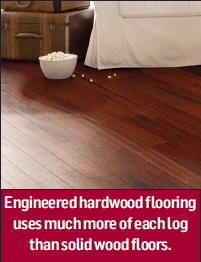Article Number: 3817
Selling green: A ‘how to’ for hard surface flooring
By Betsy Amoroso, Communications manager, Mannington Mills
Today, in every facet of our lives, there’s a keen awareness to be less wasteful and more efficient. The flooring industry is no exception. Flooring is being revolutionized by the green movement, and manufacturers have bumped up initiatives to produce goods that have less impact on the environment.
In the process, retailers have been given another meaningful differentiator to use at the point of sale: green. Manufacturers are working to make it easier to sell green by introducing products with environmentally responsible attributes.
Green: To sell or not to sell
Many consumers see green as a differentiator in their purchasing decision, but with only 7% of consumers reporting they are true “green enthusiasts,” it’s not a primary driver for most.
Consumers are hungry for products with positive environmental attributes, but they also expect those products to have the same beauty, performance and price as their non-green counterparts. For most consumers, without the top three attributes green can become irrelevant.
Each category has a story
Category-by-category, each hard surface flooring type has its advantages, and it’s to your advantage to know what those are and communicate them to your customer. For example:
• Domestically manufactured floors use less fuel to transport from their location of origin to your store as opposed to imports.
• The use of aluminum oxide in a scratch-resistant topcoat creates a very durable surface, making for a long-lasting product.
• Engineered hardwood flooring uses much more of each log than solid wood floors, which translates into less waste.
• Laminate flooring can contain up to 74% pre-consumer (post-industrial) recycled content, and the product itself is recyclable.
• Laminates made using a direct-pressure process contain no glues or adhesives, contributing to better indoor air quality.
• Residential resilient flooring is available with recycled content saving hundreds of tons of waste from going to landfill each year.
Many manufacturers print this type of information in product brochures and on samples. You can usually find more detailed manufacturing and product-specific information on their Web sites as well. It pays to educate yourself on the subject before you’re faced with questions at the point of sale.
So no matter what category in which your customer is interested, talk to her about the environment. Gauge her knowledge and interest, and talk about the products she might choose. You’ll not only get more insight into her lifestyle needs, but you’ll demonstrate you’re on the leading edge when it comes to knowing how your products impact the environment.
Today, in every facet of our lives, there’s a keen awareness to be less wasteful and more efficient. The flooring industry is no exception. Flooring is being revolutionized by the green movement, and manufacturers have bumped up initiatives to produce goods that have less impact on the environment.
In the process, retailers have been given another meaningful differentiator to use at the point of sale: green. Manufacturers are working to make it easier to sell green by introducing products with environmentally responsible attributes.
Green: To sell or not to sell
Many consumers see green as a differentiator in their purchasing decision, but with only 7% of consumers reporting they are true “green enthusiasts,” it’s not a primary driver for most.
Consumers are hungry for products with positive environmental attributes, but they also expect those products to have the same beauty, performance and price as their non-green counterparts. For most consumers, without the top three attributes green can become irrelevant.
Each category has a story
Category-by-category, each hard surface flooring type has its advantages, and it’s to your advantage to know what those are and communicate them to your customer. For example:
• Domestically manufactured floors use less fuel to transport from their location of origin to your store as opposed to imports.
• The use of aluminum oxide in a scratch-resistant topcoat creates a very durable surface, making for a long-lasting product.
• Engineered hardwood flooring uses much more of each log than solid wood floors, which translates into less waste.
• Laminate flooring can contain up to 74% pre-consumer (post-industrial) recycled content, and the product itself is recyclable.
• Laminates made using a direct-pressure process contain no glues or adhesives, contributing to better indoor air quality.
• Residential resilient flooring is available with recycled content saving hundreds of tons of waste from going to landfill each year.
Many manufacturers print this type of information in product brochures and on samples. You can usually find more detailed manufacturing and product-specific information on their Web sites as well. It pays to educate yourself on the subject before you’re faced with questions at the point of sale.
So no matter what category in which your customer is interested, talk to her about the environment. Gauge her knowledge and interest, and talk about the products she might choose. You’ll not only get more insight into her lifestyle needs, but you’ll demonstrate you’re on the leading edge when it comes to knowing how your products impact the environment.
 |